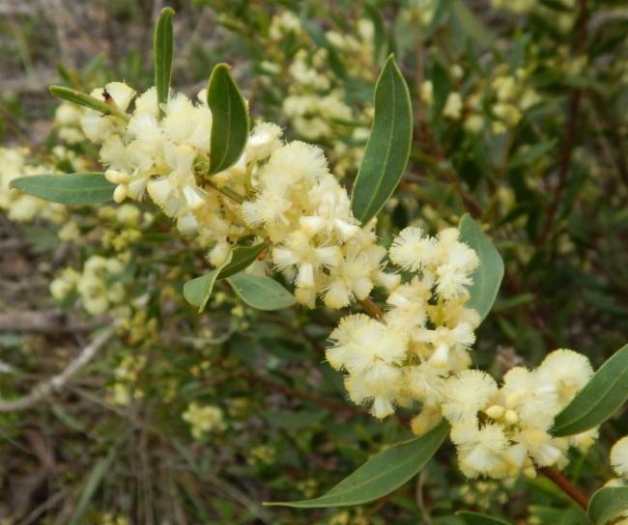Myrtle Wattle
(Acacia myrtifolia)
Myrtle Wattle (Acacia myrtifolia)
/
/

David Sando
CC BY 4.0
Image By:
David Sando
Recorded By:
Copyright:
CC BY 4.0
Copyright Notice:
Photo by: David Sando | License Type: CC BY 4.0 | License URL: http://creativecommons.org/licenses/by/4.0/ | Occurence ID: https://www.gbif.org/occurrence/1935323789 | Publisher: Atlas of Living Australia |
















































Estimated Native Range
Summary
Acacia myrtifolia, commonly known as Myrtle Wattle, is an evergreen shrub native to the sandy coastal areas, heathlands, and dry sclerophyll forests of Southern, Southeastern, and Western Australia. It typically grows to a height of 1-2 meters (3-6 feet) and a similar width, with a dense, bushy habit that provides excellent cover for birds and other wildlife. The Myrtle Wattle has fine, soft foliage with a blue-green hue and produces showy clusters of bright yellow, puffball-like flowers in the spring, which are highly attractive to pollinators such as bees.
Myrtle Wattle is valued for its drought tolerance and ability to thrive in poor, sandy soils, making it an ideal choice for low-maintenance gardens, roadside verges, and large median strips. It serves well as a windbreak, natural barrier, or for erosion control. The plant’s resilience and attractive foliage also make it suitable for ornamental use in urban and coastal landscapes. While it can be grown from seed, pre-treatment by soaking in boiling water or scarification is necessary to break seed dormancy. Propagation from cuttings is also effective. Myrtle Wattle requires full sun exposure and is adapted to low water conditions, preferring soils with fast drainage. It is relatively free from major pests and diseases but can be susceptible to root rot in poorly drained soils.CC BY-SA 4.0
Myrtle Wattle is valued for its drought tolerance and ability to thrive in poor, sandy soils, making it an ideal choice for low-maintenance gardens, roadside verges, and large median strips. It serves well as a windbreak, natural barrier, or for erosion control. The plant’s resilience and attractive foliage also make it suitable for ornamental use in urban and coastal landscapes. While it can be grown from seed, pre-treatment by soaking in boiling water or scarification is necessary to break seed dormancy. Propagation from cuttings is also effective. Myrtle Wattle requires full sun exposure and is adapted to low water conditions, preferring soils with fast drainage. It is relatively free from major pests and diseases but can be susceptible to root rot in poorly drained soils.CC BY-SA 4.0
Plant Description
- Plant Type: Shrub
- Height: 4-10 feet
- Width: 2-6 feet
- Growth Rate: Rapid
- Flower Color: Yellow
- Flowering Season: Spring, Winter
- Leaf Retention: Evergreen
Growth Requirements
- Sun: Full Sun
- Water: Low
- Drainage: Fast
Common Uses
Bee Garden, Bird Garden, Drought Tolerant, Hummingbird Garden, Low Maintenance
Natural Habitat
native to the sandy coastal areas, heathlands, and dry sclerophyll forests of Southern, Southeastern, and Western Australia
Other Names
Common Names: Red Stem Wattle, Red-Stemmed Wattle
Scientific Names: , Acacia myrtifolia, Acacia marginata, Acacia marginata var. angustata, Mimosa myrtifolia, Acacia acutifolia, Acacia myrtifolia var. angustifolia, Acacia marginata var. brevifolia, Acacia myrtifolia f. angustifolia, Acacia myrtifolia f. normalis
GBIF Accepted Name: Acacia myrtifolia (Sm.) Willd.